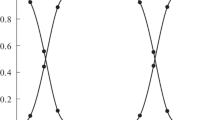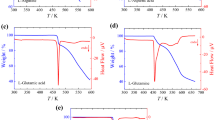Abstract
The energies of combustion of creatine (anhydrous and monohydrate), creatinine, and arginine were measured in a static bomb adiabatic calorimeter, in pure oxygen at 3,040 kPa. The derived standard enthalpies of formation in solid state of the above-mentioned compounds are, respectively, −520.4 ± 4.3, −809.7 ± 1.3, −204.2 ± 7.0, and −634.8 ± 2.3 kJ mol−1 . The data of enthalpy of formation are compared with literature values and with estimated values by means of group additivity. The dehydration of creatine monohydrate and the processes occurring in the three guanidine derivatives at temperatures exceeding 200 °C were investigated by means of DSC.




Similar content being viewed by others
References
Huffman HM, Ellis EL, Fox SW. Thermal data. VI. The heats of combustion and free energies of seven compounds containing nitrogen. J Am Chem Soc. 1936;58:1728–33.
Johnson WH. The enthalpies of combustion and formation of nicotinic acid and creatinine. J Res NBS. 1975;79:425–9.
Yang XW, Liu JR, Gao SL, Hou YD, Shi QZ. Determination of combustion energies of thirteen amino acids. Thermochim Acta. 1999;329:109–15.
Huffman HM, Fox SW, Ellis EL. Thermal data. VII. The heats of combustion of seven amino acids. J Am Chem Soc. 1937;59:2144–9.
Oscarson JL, Rowley RL, Wilding WV, Izatt RM. Industrial need for accurate thermophysical data and for reliable prediction methods. J Therm Anal Calorim. 2008;92:465–70.
Mojumdar SC, Sain M, Prasad RC, Sun L, Venart JES. Selected thermoanalytical methods and their applications from medicine to construction. Part I. J Therm Anal Calorim. 2007;90:653–62.
Westrum EF. Presentation of combustion calorimetric data in the primary literature. In: Sunner S, Månsson M, editors. Combustion calorimetry, experimental chemical thermodynamics, Chap. 7, vol. 1. Oxford: Pergamon Press; 1979.
Ribeiro da Silva MAV, Cabral JITA. Standard molar enthalpy of formation of 1-cyano-acetylpiperidine. J Therm Anal Calorim. 2008;92:59–62.
Coops J, Jessup RS, van Nes K. Calibration of calorimeters for reactions in a bomb at constant volume. In: Rossini FD, editor. Experimental thermochemistry, Chap. 3, vol. 1. New York: Interscience; 1956.
Chase MW Jr. NIST-JANAF thermochemical tables, fourth edition. J Phys Chem Ref Data Monogr. 1998;9:1–1951.
Washburn EW. Standard states for bomb calorimetry. J Res Natl Bur Stand. 1933;10:525–58.
Cox JD, Pilcher G. Thermochemistry of organic and organometallic compounds. London: Academic Press; 1970.
CODATA Bulletin nr. 28 (April 1978), Recommended key values for thermodynamics; 1977.
Pedley JB, Naylor RN, Kirby SP. Thermochemical data of organic compounds. 2nd ed. London: Chapman and Hall; 1986.
Dash KA, Yoonsun Mo, Pyne A. Solid-state properties of creatine monohydrate. J Pharm Sci. 2002;91:708–18.
Malaj L, Censi R, Di Martino P. Mechanisms for dehydration of three sodium naproxen hydrates. Cryst Growth Des. 2009;9:2128–36.
Malik T, Karr T, Bocelli G, Musatti A. Structural and thermal characterization of l-arginine dihydrate—a nonlinear optical material. Cryst Res Technol. 2006;41:280–4.
Kofler L, Sitte H. Melting point determination of substances which melt with decomposition. Monatsh Chem. 1950;81:619–26.
Domalski ES, Hearing ED. Estimation of the thermodynamic properties of C-H-N-O-S-halogen compounds at 298.15 K. J Phys Chem Ref Data. 1993;22:805–1160.
Roux MV, Smith PJ, Liebman JF. Paradigms and paradoxes: thoughts on the enthalpy of formation of guanidine and its monosubstituted derivatives. Struct Chem. 2005;16(1):73–5.
Kabo GYa, Miroshnichenko EA, Frenkel ML, Kozyro AA, Siminskii VV, Krasulin AP, Vorob’eva VP, Lebedev YuA. Thermochemistry of urea alkyl derivatives. Bull Akad Sci USSR Div Chem Sci 1990;39:662–7.
Salmon A, Dalmazzone DJ. Prediction of enthalpy of formation in the solid state at 298.15 K using second-order group contributions—part 2: carbon-hydrogen, carbon-hydrogen oxygen, and carbon-hydrogen-nitrogen-oxygen compounds. Phys Chem Ref Data. 2007;36:19–58.
Contineanu I, Neacsu A, Perisanu St. The standard enthalpies of formation of l-asparagine and l-α-glutamine. Thermochim Acta. 2010;497:96–100.
Acknowledgements
The authors are grateful for the financial support from the research grant—GAR nr. 50/06.08.2007 of the Romanian Academy.
Author information
Authors and Affiliations
Corresponding author
Rights and permissions
About this article
Cite this article
St. Perisanu, Contineanu, I., Neacsu, A. et al. The calorimetric study of some guanidine derivatives involved in living bodies nitrogen metabolism. J Therm Anal Calorim 101, 1127–1133 (2010). https://doi.org/10.1007/s10973-010-0682-3
Received:
Accepted:
Published:
Issue Date:
DOI: https://doi.org/10.1007/s10973-010-0682-3




